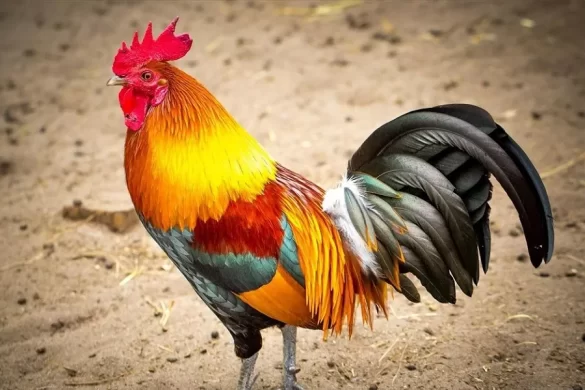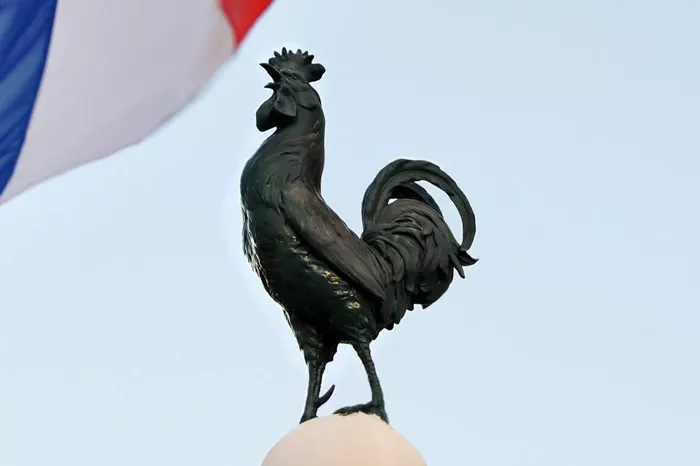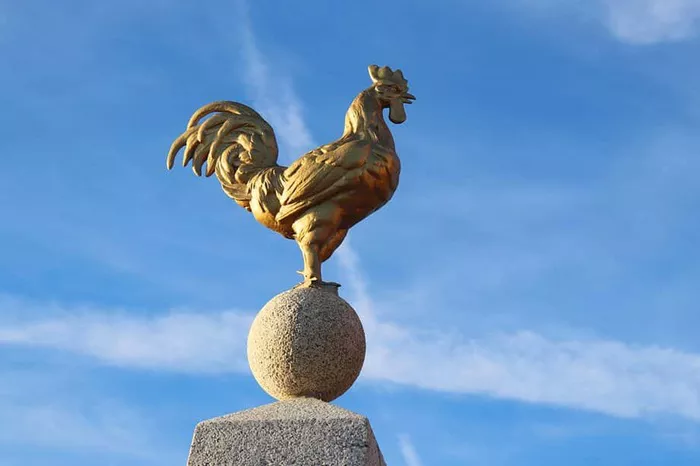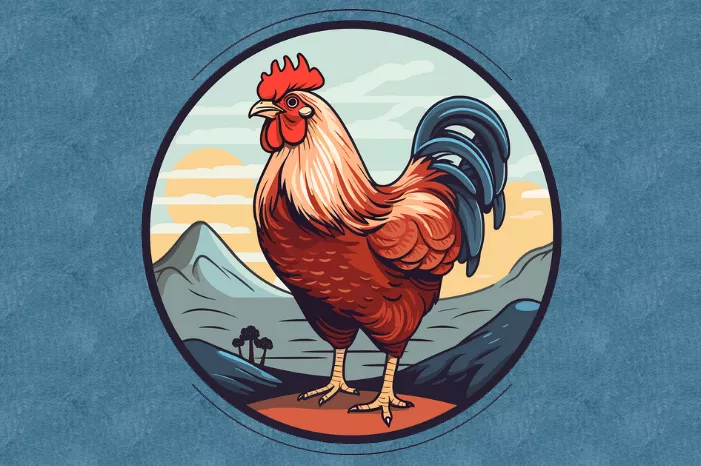The Gallic Cock, also known as the Gallic Rooster or “le coq gaulois,” is more than just a bird in France; it is a national emblem that resonates deeply with the French people. This proud and vigilant creature has been a symbol of courage, resilience, and national pride throughout France’s history, from the early Middle Ages to the present day. As a representation of the French nation, the Gallic Rooster stands as a testament to the country’s enduring spirit and cultural heritage. Napoleon dismissed the rooster as an emblem unworthy of representing a great empire like France, opting instead for the imperial eagle.
France is a country in Europe known for its food, fashion, and famous landmarks like the Eiffel Tower. But did you know that France also has a national bird?
In this article, we will explore the fascinating history, symbolism, and modern significance of the Gallic Rooster, uncovering why it continues to be a beloved icon in France.
What Is a National Bird?
Before we talk about France’s national bird, let’s first understand what a national bird is.
A national bird is a bird that has been chosen by a country as an important symbol. It usually represents the values, beliefs, or history of the country. For example:
- The Bald Eagle is the national bird of the United States.
- The Peacock is the national bird of India.
- The Kiwi is the national bird of New Zealand.
- The French Rooster is the National Bird of France.
These birds are not just animals. They have meaning. They help tell a story about the country they represent.
So, What Is the National Bird of France?
The national bird of the French Republic is the Gallic Rooster, also known as the Gallic Cock. In French, it is called “le coq gaulois.” It is a proud-looking rooster that often stands tall with its chest out. This bird is a symbol of pride, courage, and resilience for the French people. It has a bright red comb, a golden or reddish body, and strong legs. The Gallic rooster also embodies France’s courage, determination, and virility, making it a powerful representation of the nation’s character.
The origin of the Gallic Rooster as a national symbol traces back to the Middle Ages and its association with the Gauls. Interpretations of France’s origins have evolved, particularly during the French Revolution, shifting from royalist views to a republican perspective that emphasizes the ancient Gaul as foundational to French identity.
The rooster’s crow represents hope and wakefulness, which is why it is an important figure in French culture. You can often see it on flags, coins, and sports jerseys in France. The Gallic Rooster is also linked to France’s history. It was used as a symbol during the French Revolution and has remained an icon of freedom and determination ever since.
The History of the Gallic Rooster (le coq gaulois)
The connection between the rooster and France dates back to ancient times. The Latin name for Gaul, the region that is now France, was “Gallia.” This word sounds similar to “Gallus,” which means rooster in Latin. Because of this similarity, the rooster became a symbol of the people of Gaul.
During the Roman period, the rooster was seen as a sign of bravery. The people of Gaul were known for their courage in battle. Even though they were conquered by the Romans, they never lost their fighting spirit. The rooster became a symbol of this determination. In the Middle Ages, the rooster played a significant role as a symbol in medieval France, linking its origins to the Latin terms for rooster and the inhabitants of Gaul.
In the Middle Ages, the rooster was associated with Christianity. It was often shown in churches as a sign of faith and hope. Many churches in France had rooster-shaped weathervanes on their roofs. These weathervanes reminded people to stay strong in their beliefs. The biblical account of Jesus predicting Peter’s denial is linked to the rooster’s crowing, symbolizing vigilance and alertness among Christians. Peter recalled Jesus predicting his denial after the crowing of the rooster, emphasizing the rooster’s symbolic significance in Christianity. The rooster’s crowing is a metaphor for the triumph of light over darkness and the symbolism of watchfulness in Christian teachings. Additionally, the rooster alerted people to disturbances during the night, underscoring its connection to themes of awareness and readiness. The rooster became a symbol of vigilance mentioned in the Bible, specifically in the Passion of Jesus-Christ.
During the French Revolution (1789-1799), the rooster became a powerful symbol of the new republic. It represented the bravery of the French people as they fought for freedom and equality. During the Renaissance, the French Kings officially decorated official badges and coins with the image of a rooster. In 1830, the “Gallic Rooster” replaced the fleur-de-lis as the national emblem, and it was again discarded by Napoleon III. However, during the Third Republic period, the French rooster enjoyed its glory, and its patterns were engraved on seals and gold coins at that time. The Third Republic eagerly re-established the rooster as an official symbol after the French Revolution, further cementing its place in French culture.
Symbolism of the French Rooster
The Gallic Rooster carries a wealth of symbolic meaning. It embodies several important qualities that are valued in French culture:
1. Courage and Strength: The rooster is known for its bravery and fighting spirit. It stands tall and proud, facing challenges with determination. During the Second World War, it became a symbol of resistance, courage, and patriotism. The Gallic rooster’s association with resistance and patriotism during World War II further highlights its enduring significance as a national emblem.
2. Vigilance and Alertness: The rooster’s crow at dawn symbolizes vigilance and awareness. It represents the French people’s commitment to staying alert and protecting their nation. The crow at dawn also signifies the daily victory of light over darkness. A biblical passage invokes the symbolism of vigilance associated with the rooster, highlighting a moment of alertness during a significant event.
3. Pride and Independence: The rooster’s proud posture and loud crow express a sense of national pride and independence. It represents the French people’s strong sense of identity and their desire to maintain their autonomy. The rooster’s physicality and spirit portray it as a proud and resilient figure, embodying traits such as courage and patriotism.
4. Resurrection and Renewal: The rooster’s crow heralds the dawn, symbolizing the start of a new day and the promise of renewal. This aligns with the historical use of the rooster during the revolution, signifying a new beginning for France. The rooster also represents the triumph of light over darkness and serves as a Christian emblem of victory.
5. Rural Roots: The rooster is inherently tied to agricultural life, and thus symbolizes the strong connection that French people have with their land and rural traditions.
The Gallic Rooster in Modern France
Even today, the rooster is an important symbol in France. It can be seen in different aspects of French life:
The Gallic Rooster is prominently featured in various sporting events such as football and rugby, representing French teams and their spirit during competitions. It also serves as a powerful mascot for various national teams in events like football and rugby. Additionally, the Gallic Rooster has been prominently featured in various war memorials, especially following World War I. In Wallonia, the ‘coq hardi’ is a specific depiction of a rooster that serves as the symbol of the region, representing a ‘bold rooster’ raising its claws.
Sports and the Rooster
The Gallic Rooster is a famous symbol in French sports. Roosters have a historical and cultural significance in French identity, emerging as a national symbol during the Roman era. The etymological significance of the term ‘play’ within the historical background of the Gallic rooster as a national symbol of France is notable. The phrase ‘cock-a-doodle-doo’ is associated with the Gallic rooster as a national symbol of France. The French national football (soccer) team has a rooster on its jerseys. The rooster represents strength and teamwork. French rugby teams also use the rooster as their emblem. In France, the rooster’s crowing sound is ‘cocorico,’ which is sometimes used as an expression of national pride, especially during sporting victories.
French Coins and Stamps
In the past, the rooster was featured on French franc coins before France switched to the euro. The image of the rooster is still found on stamps and other national items. Notably, the Gallic rooster was depicted on the reverse of French 20-franc gold pieces from 1899 to 1914, showcasing its historical and cultural importance.
Political and Military Symbols
The rooster appears on many official French buildings and government documents. The Gallic Rooster returned as an official emblem under the July Monarchy and later during the Second Republic. It was officially designated during the Second Republic, highlighting its cultural significance. The rooster’s association with France developed alongside its use by various political regimes, particularly during the Renaissance and the French Revolution. It is often used by political leaders to represent national unity. The French military also uses the rooster as a sign of bravery.
The Rooster vs. Other Symbols of France
France has many symbols. Here’s how the rooster compares to other national symbols:
| Symbol | Meaning | Where It Appears |
|---|---|---|
| Marianne | Liberty, reason | Government logos, stamps |
| The Tricolor Flag | Freedom, unity | Everywhere |
| The Gallic Rooster | Pride, courage | Sports teams, coins |
| The Fleur-de-lis | French monarchy | History, art |
| La Marseillaise | National anthem | Music, ceremonies |
All of these symbols work together to show what France stands for. While not an official emblem, the rooster holds a unique place in the hearts of the French people, representing their spirit and national character.
The economic performance of France is often compared to that of England, implying a sense of rivalry and national identity between the two nations. Historically, regions that are now part of Germany were significant in ancient Gaul, highlighting the cultural and historical interactions between the Romans and various tribes. Additionally, the French preference for local produce and the cultural value placed on seasonal eating lead to an aversion toward tomatoes from Spain, emphasizing their commitment to supporting local agriculture.
Conclusion
The Gallic Rooster is more than just the national bird of France. It is a powerful symbol of the country’s history, values, and culture. It represents courage, pride, resilience, and vigilance. From ancient times to the modern era, the rooster has been a proud emblem of the French spirit. Whether seen on sports jerseys, coins, or government buildings, the Gallic Rooster continues to remind the world of France’s strength and determination.
Frequently Asked Questions
Q: Why is the rooster a symbol of France?
The Latin word for both “rooster” and “Gaul” is “Gallus,” which led to the rooster becoming a symbol of French pride and history. The historical significance of the term ‘gallus’ can be traced back to the Roman era, where it denoted both the people of Gaul and a cockerel. The origins of the Gallic Rooster as a national symbol of France are deeply rooted in the etymological connection to ancient Gaul and were redefined during the French Revolution. This clever linguistic twist in Latin between the terms ‘Gallus,’ meaning an inhabitant of Gaul, and ‘gallus,’ meaning rooster, was initially used by the enemies of France to mock the French, but was later adopted by French kings as a symbol, highlighting its dual meanings and cultural significance.
Q: Is the rooster used on the French flag?
A: No, the French flag is just blue, white, and red. The rooster is used in sports and cultural symbols.
Q: Where can I see the Gallic Rooster in France?
On sports team logos, coins, buildings, and in artwork. The Gallic Rooster, a symbol of the French, represents their spirit and national character. The Gallic rooster is a significant emblem for France, embodying cultural and patriotic values throughout its historical journey. The cockerel, historically significant, personifies the courage and resilience of the early inhabitants of France, the Gauls.
Q: Why is France called the French republic?
France is called the French Republic because it operates as a republic, which is a form of government where the country is considered a public matter, and its leaders are elected by the people or their representatives. The term “French Republic” reflects the nation’s commitment to principles like liberty, equality, and fraternity, which were established during the French Revolution in the late 18th century. Over time, France has had several republics, and the current one is the Fifth Republic, established in 1958. This name emphasizes the democratic and secular values that are central to France’s identity and governance.





 Facebook
Facebook  Instagram
Instagram  Youtube
Youtube 